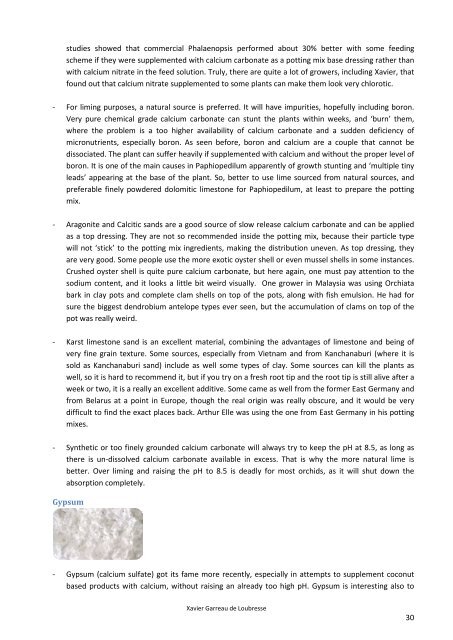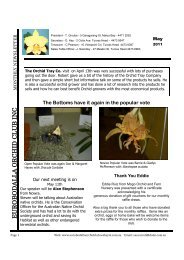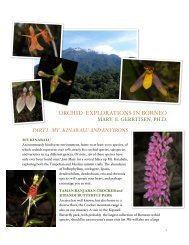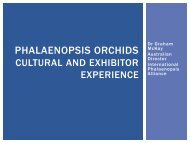Orchid Growing Substrates
Orchid Growing Substrates
Orchid Growing Substrates
Create successful ePaper yourself
Turn your PDF publications into a flip-book with our unique Google optimized e-Paper software.
studies showed that commercial Phalaenopsis performed about 30% better with some feeding<br />
scheme if they were supplemented with calcium carbonate as a potting mix base dressing rather than<br />
with calcium nitrate in the feed solution. Truly, there are quite a lot of growers, including Xavier, that<br />
found out that calcium nitrate supplemented to some plants can make them look very chlorotic.<br />
- For liming purposes, a natural source is preferred. It will have impurities, hopefully including boron.<br />
Very pure chemical grade calcium carbonate can stunt the plants within weeks, and ‘burn’ them,<br />
where the problem is a too higher availability of calcium carbonate and a sudden deficiency of<br />
micronutrients, especially boron. As seen before, boron and calcium are a couple that cannot be<br />
dissociated. The plant can suffer heavily if supplemented with calcium and without the proper level of<br />
boron. It is one of the main causes in Paphiopedilum apparently of growth stunting and ‘multiple tiny<br />
leads’ appearing at the base of the plant. So, better to use lime sourced from natural sources, and<br />
preferable finely powdered dolomitic limestone for Paphiopedilum, at least to prepare the potting<br />
mix.<br />
- Aragonite and Calcitic sands are a good source of slow release calcium carbonate and can be applied<br />
as a top dressing. They are not so recommended inside the potting mix, because their particle type<br />
will not ‘stick’ to the potting mix ingredients, making the distribution uneven. As top dressing, they<br />
are very good. Some people use the more exotic oyster shell or even mussel shells in some instances.<br />
Crushed oyster shell is quite pure calcium carbonate, but here again, one must pay attention to the<br />
sodium content, and it looks a little bit weird visually. One grower in Malaysia was using Orchiata<br />
bark in clay pots and complete clam shells on top of the pots, along with fish emulsion. He had for<br />
sure the biggest dendrobium antelope types ever seen, but the accumulation of clams on top of the<br />
pot was really weird.<br />
- Karst limestone sand is an excellent material, combining the advantages of limestone and being of<br />
very fine grain texture. Some sources, especially from Vietnam and from Kanchanaburi (where it is<br />
sold as Kanchanaburi sand) include as well some types of clay. Some sources can kill the plants as<br />
well, so it is hard to recommend it, but if you try on a fresh root tip and the root tip is still alive after a<br />
week or two, it is a really an excellent additive. Some came as well from the former East Germany and<br />
from Belarus at a point in Europe, though the real origin was really obscure, and it would be very<br />
difficult to find the exact places back. Arthur Elle was using the one from East Germany in his potting<br />
mixes.<br />
- Synthetic or too finely grounded calcium carbonate will always try to keep the pH at 8.5, as long as<br />
there is un-dissolved calcium carbonate available in excess. That is why the more natural lime is<br />
better. Over liming and raising the pH to 8.5 is deadly for most orchids, as it will shut down the<br />
absorption completely.<br />
Gypsum<br />
- Gypsum (calcium sulfate) got its fame more recently, especially in attempts to supplement coconut<br />
based products with calcium, without raising an already too high pH. Gypsum is interesting also to<br />
Xavier Garreau de Loubresse<br />
30
















